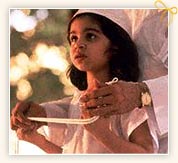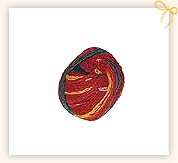 In Hindu religion, threads are used for different
purposes and accordingly religious threads can be classified as
follows :
In Hindu religion, threads are used for different
purposes and accordingly religious threads can be classified as
follows :
 |
||||||||||||||
|
|
||||||||||||||
HinduOfUniverse
Religious Threads In Hindu religion, threads are used for different
purposes and accordingly religious threads can be classified as
follows :
In Hindu religion, threads are used for different
purposes and accordingly religious threads can be classified as
follows :
Janeu/Janou Thread Janeu or Janou is a sacred thread worn by all Hindu
Brahmins to mark the transition of a young male's life-from being a
child to a young boy to becoming a man. Brahmins mark this
transition with the "Upanayanam Samskara" (the sacred thread
ceremony) and is usually performed between the ages of seven and
fourteen. If, for some reason, it has not been done during this age
period, then it needs to be completed before he gets married. This
ceremony is a very ancient one. So long the boy doesnot wear the
janeo or the sacred thread, he could not be reckoned among the "Dvija"
(twice born).
Janeu or Janou is a sacred thread worn by all Hindu
Brahmins to mark the transition of a young male's life-from being a
child to a young boy to becoming a man. Brahmins mark this
transition with the "Upanayanam Samskara" (the sacred thread
ceremony) and is usually performed between the ages of seven and
fourteen. If, for some reason, it has not been done during this age
period, then it needs to be completed before he gets married. This
ceremony is a very ancient one. So long the boy doesnot wear the
janeo or the sacred thread, he could not be reckoned among the "Dvija"
(twice born).The janeo thread is not only worn by the brahmins but also by Kshatriyas and by Vaishyas. If a Brahmin wishes to become learned in the Vedas, he should wear the janeo at the age of 5 years; if a Kshatriya wishes to gain strength, he should wear the thread at 6, and for a Vaishya, if he wishes for success, he should wear the Janeu at the age of 8. Janeu Thread Material This sacred thread of the Brahmins is made of cotton, that of a Kshatriya of hempen threads and that of a Vaisya of woollen threads. Form of the Janeu The form of the Janeu is different for different caste groups or sects. These forms are as follows :
Meaning of the Three Strands of the Janeu
Different Methods of Wearing the Thread
Anant Chaudas Thread Bhadrapad Shukl Chaturdashi or Anant
Chaturdashi, is an auspicious day. This day is a day with twin
significance. It is the last day of the Ganesh festival, which
begins with Ganesh Chaturthi. Chaturdashi is the tenth day after
Ganesh Chaturthi and it is the day when the idols of Ganesha are
immersed in water. On this day, a sacred thread called the Anant
Chaudas Thread is worn as armlet or round the neck by both males
and females. Some prefer to tie the thread at the main entrance door
of their homes. The significance of this thread is that Lord Ganesh
should bless everyone with health, happiness and prosperity while
leaving the house and take away all miseries and sorrows of people.
Anant means endless, infinite. The thread awards infinite happiness,
by blessings of Lord Vishnu and Lord Ganesha.
Bhadrapad Shukl Chaturdashi or Anant
Chaturdashi, is an auspicious day. This day is a day with twin
significance. It is the last day of the Ganesh festival, which
begins with Ganesh Chaturthi. Chaturdashi is the tenth day after
Ganesh Chaturthi and it is the day when the idols of Ganesha are
immersed in water. On this day, a sacred thread called the Anant
Chaudas Thread is worn as armlet or round the neck by both males
and females. Some prefer to tie the thread at the main entrance door
of their homes. The significance of this thread is that Lord Ganesh
should bless everyone with health, happiness and prosperity while
leaving the house and take away all miseries and sorrows of people.
Anant means endless, infinite. The thread awards infinite happiness,
by blessings of Lord Vishnu and Lord Ganesha.
Sacred Red Thread/Mauli/Kalawa
Mouli or Kalawa
is a cotton red thread roll, considered to be very sacred and used
in all religious purposes of the Hindus. The thread is used as an
offering of cloth to the deity. The Mouli thread is an
integral part of any puja. Normally the Mouli is tied around
the Sadhana article, that is, Mouli is tied around a copper
tumbler filled with water. On its mouth is placed five mango leaves
and a coconut in a red cloth is place it over the mouth of the
tumbler. This represents the shrine you are offering puja. Next,
before the start of the puja, the red sacred thread is tied around
the wrist of the members of the family. As a rule, all males and
married females wear it on the right hand. Unmarried females wear it
on their left hands. Only the Brahmin females, both married and
unmarried can wear it in their right hands. The basic significance
of wearing this thread is to get blessings from God.
|
||||||||||||||